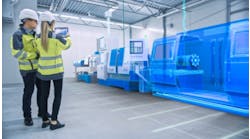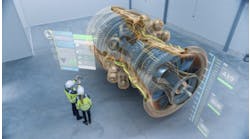New tools simulate, augment industrial reality
Preparing a new generation of workers for careers in industry is challenging enough. Add to that a demographic wave of retirement among experienced workers, new technologies with as yet undefined requisite skills, and our propensity to informally pass knowledge from senior workers to new recruits like tales around a campfire, and industry today finds itself in a skills development crisis.
“One of the things we’ve been wrestling with is how to digitize that tribal knowledge and essentially institutionalize things like best practices and present it in a medium that the new workforce can take advantage of,” explained Rob McGreevy during a panel discussion on these and other personnel productivity issues at Smart Industry 2015 in Chicago.
McGreevy, VP information, operations & asset management at Schneider Electric and responsible for business operations, said that the new generation of workers come in expecting things to be mobile and solution-oriented. This is a large change for an industry where the environment has traditionally been more modular and protected. “Simulation and training using virtual reality,” said McGreevy, “is one way of taking counter-performing test activities and, for example, instead giving a test simulation on how to deal with a fire.”
Willing to learn
New workers also find it difficult to prepare for future needs when they don’t know what tools they will be using in, say, three years’ time, said fellow panelist Paul Davies, associate technical fellow in the Advanced Production Systems group at Boeing Research & Technology. “We look for people constantly willing to learn new things and to not be satisfied with the status quo, but being open to change. That has worked out well for me and for my team,” he explained. Davies is currently the principal investigator for technology development projects in augmented reality, machine vision and advanced visualization techniques in the manufacturing domain.
In the past, operators were taught using a manual paper-based or flat human-machine interface (HMI) visualization screen. Now with virtual reality (VR) programs, the worker can be fully immersed in the environment. They can do a simulation where they literally walk through a virtual refinery and simulate a shutdown in a fire scenario. In this simulation, McGreevy said, workers even pick up the gear needed for the exercise. Going through the scenario, they experience not only a projection of the physical plant, but also the control systems.
Engagement boosts learning efficiency
A major benefit of VR is that it gives workers the opportunity to get out of the classroom and onto the floor more quickly, said Barry Po, senior director of product development at NGRAIN, a provider of interactive 3D augmented reality and virtual reality technology. He pointed out that workers are able to engage with the content and become expert much more quickly, because of the improved student to object connection gained by the simulation.
“Spending less time in the classroom is obviously a big thing, especially when you work with a lot of workers who may have high turnover,” continued Po. “It’s very expensive to train people in the classroom. It’s even more expensive when you realize that training them up to the level where they are expert is very difficult when all they’re doing is passively accepting knowledge. One of the things you can do in VR that you can’t do by reading a textbook is to actually get the student engaged with the content, because they’re actually doing the task as opposed to just learning about it through rote knowledge.”
Justifying investments
If the training method being used at your plant right now seems sufficient, how do you justify the expense of improving training with new virtual technologies? Sometimes the simplest solution is still the best. In some situations, taking a video of a task being performed and using that for training may be the best way to pass along the necessary information.
If the task is more complicated, then a higher-technology solution may be worth the investment. At Iowa State University, for example, Davies worked with a group to test the value of augmented reality (AR) training over more traditional training methods. Student participants were asked to put together a mock airplane wing. One group had instructions on a desktop computer, another on a mobile tablet. The last group had the instructions converted to an AR registered as an overlay on the assembly. In this case, a blue digital object in the form of a 3D model was rendered on the screen in the proper position for assembly, as if it were in the physical world.
The testers found that the group using the AR instructions experienced a 90% reduction in the number of errors during the assembly when compared to the group using instructions on the desktop computer. The time to build the wing was also reduced by about 35%.
McGreevy suggested identifying the training areas that will deliver the most value – start smaller where you will see the biggest returns. Start with the current state as a benchmark and then do an assessment. Look for others who have implemented similar improvements instead of reinventing the wheel. It also makes sense to standardize processes so that you can roll out one solution across multiple sites rather than making changes piecemeal.
“We try to dissuade companies from doing a big bang investment,” added Po. “It’s better to set aside a certain amount of capital for improvements so that, when the technology becomes available, you have the capital ready.”
Practical implementation
There can be great value in involving workers early in the design process. “If people are engaged in the design cycle, their willingness to adopt is much greater,” pointed out Po. “If change is forced upon people, then acceptance will be far less.”
Davies agreed that it’s critical to involve end users through development to get the best adoption. “First we would tell them what we’re trying to do so they understand the goal. Then we develop the first iteration, and work with them while they do their job with the tool. Then, after a couple weeks using the new tool, we’d ask what the workers liked and what didn’t work with it,” Davies explained. “Then we’d make changes. For example, they might have suggestions for new features that they’d like to see, so we would add those features and really get them engaged in the whole development process. You just get much better adoption if you make the user a stakeholder.”
“One of the things that’s really important as well as having the technology,” Po said, “is to have the culture to embrace change and just accept it as the natural course of how the business will operate going forward.”
Technology can sometimes become a crutch, and planners are cautioned not to view technology as the replacement for a skill. Keep in mind that you should balance the need and desire for new technology with the fact that it will sometimes fail – and you need to be able to cope without it.



